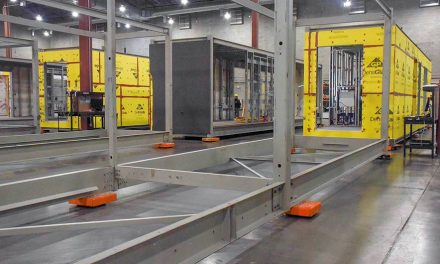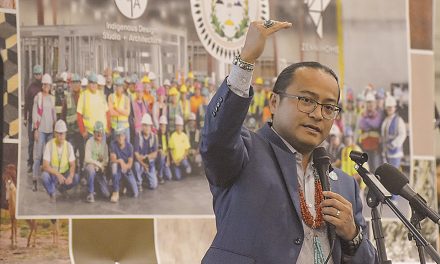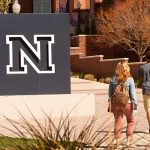
Letters: Permanent sources of revenue

I am writing this letter to inform our Navajo citizens on the history of the creation of two ideas that would create and launch the permanent sources of revenue for the Navajo Nation into the future.
In the 1970s, I was employed by the Navajo Nation in what was the forerunner of the Division of Economic Development and that department was called Program Development.
At one of the first staff meetings, a presentation was made by Mr. Aktar Zaman, a staff member of the Minerals Department, who explained the total source of revenues that the Navajo Nation was receiving from oil, natural gas, coal, and other natural resources.
He made a chart showing the anticipated revenues going in an upward curve, leveling off and then a downward trend line. We, the staff members, asked when the downward curve would happen and he responded by saying that all natural resources are finite, meaning that once the resource was gone, it was gone forever. But Mr. Zaman had no definite time at which this would occur.
Another event that would open our eyes is the Wounded Knee incident that occurred in 1973. The American Indian Movement was called in by the Sioux elders to assist in the disputes with their tribal government and the Bureau of Indian Affairs. This became a media event and television coverage was daily.
One of the news teams got into the camp (that was surrounded by the federal forces) and interviewed an AIM member. At the end of the interview the TV newscaster asked the AIM member for a concluding remark. It did not take him long to say to TV viewers that ” all Americans should understand that Native American tribes are sovereign.”
If there was ever a message, this was a home run, a bolt of lightning out of the sky, because in Window Rock, all our Council members and tribal chairmen had never said the word “sovereign.”
I believe this happens because we became very complacent and dependent on the Bureau of Indian Affairs and they (BIA) understood we were sovereign but did not tell our leaders because they wanted to be in control of Indian reservations.
This caused us to look at the concept of “sovereign.” The day after viewing the newscast, we had a staff meeting to discuss the various attributes of a sovereign entity. We recalled some of these attributes and listed them on the blackboard and one in particular stood out and that was the power to tax.
A young lady staff member named Stella Saunders raised her hand and said she would spearhead the new project to give the Navajo Nation a new source of revenue. She assembled a Navajo Nation Tax Commission to craft new laws to create this revenue source.
Another concept paper was written on developing a Permanent Trust Fund. The main engine for this concept is called “compounding.” It is a technique in which it takes an investment and all of the interest and dividends earned and added back into the main investment fund to make it grow.
There is a similar investment fund that uses the same strategy and operated by American business magnate named Warren Buffett. The investment fund he established is called the Berkshire Hathaway “A” Fund that was started in the 1960s.
I remember reading about this fund when it was at $30 billion, grew to $40 billion and most recently at $75 billion. A recent news article on the Berkshire Hathaway “A” Fund states that this fund is earning $1 trillion per month.
It is my hope that our tribal leaders, and particularly the Council delegates, can see and understand this, as our need for financial resources will only increase, because in 1955, our tribal population was at 75,000; in 1977 this increased to 150,000; and most recently went over 300,000 in the year 2000.
Fast-forward to today, it appears that the political leaders are coming up for re-election and launching a scheme to buy votes. They would like to take monies from the Permanent Trust Fund and to build all-weather roads, however, this is not a program using the Navajo Nation Division of Transportation but assigned to Council delegates to cover various districts.
It is similar to the scheme that created the downfall of 77 of 88 delegates that concocted a similar scenario to create a discretionary fund that they controlled and stole from. We could get the same result as our previous experience, but we could also launch our own projects of building all-weather roads by issuing bond financing and give the monies to Navajo Nation Department of Transportation with clear instructions to build roads.
Our people need to understand the importance of the Permanent Trust Fund as it will be our only source of future revenues that we can control and grow to meet our future needs. If we start to use and spend it for political purposes, we are being misled.
If we allow it to grow to $26 billion then we can use it to shore up our tribal budget yet continue to grow the fund. For example, if we earn 5 percent earnings on the $26 billion, this would be approximately $1.3 billion. The tribe could then take $800 million to use in their annual appropriation process. The remaining $500 million would be used to continue growing the fund into perpetuity.
I hope this puts us on the path to survival and eventual prosperity. Because of my experience, if there is ever an election to take money from the Permanent Trust Fund, I am urging everyone to vote no on the use of monies from the fund and that is not now until the principle amount is close to $26 billion.
I would like to take this last paragraph to honor people who understood the vision and helped it get off the ground and of course this is the former Navajo Nation President Peterson Zah, Mr. Bobby White, Ms. Stella Saunders, Mr. Ernie Stevens Sr., and all other staff members and Council delegates who helped and witnessed the beginning of these two ideas. I also appreciate the support of the Begay/Nez administration on this matter.
Elroy Drake
Window Rock, Ariz.
Bluff Rd. remains neglected
The Bluff Road (NR542) in Shiprock, continues to cause stress to people and damage to vehicles as it remains neglected and long overdue for maintenance of any type.
The Bluff Road (NR542) is badly in need of grading, but by which department Ð Navajo Department of Transportation or the BIA Division of Transportation? Who will fix this road? Who has the authority to sign and give authorization for repairs?
According to the BIA Road Department, and what they do, they claim to “repair and do maintenance of roads and bridges” (bia.gov). The mission statement for Division of Transportation states: “To provide for and assist tribes in the development of their capacity to plan, construct and maintain safe and efficient transportation networks.”
Surrounding chapter communities like San Juan Chapter, Cudei, Beclabito, and Red Valley have better roads than ours. What are the chapter officials doing to get their roads graded, paved, and fixed?
While we are waiting for real road construction to begin, we need the Bluff Road to be graded. Road construction is supposed to start this month, according to source at Shiprock Chapter, but now the month is ending and a new month is approaching. Was this “fake news”?
This Bluff Road is our everyday route to doctor appointments, the grocery store, the post office, work, and emergencies. School buses from Shiprock schools bounce around up and down this road during the school year, summer school, and soon the beginning of a new school year. That adds to the bus wear and tear of tires, wheels, and brakes.
How long will we farm road residents have to put up with driving on a terrible road?
Wilford R. Joe
Shiprock, N.M.
NGS replacement lease will cause more damage
As a Navajo grassroots organization, we informed and urged the Council delegates as well as the president and vice president to not sign the NGS replacement lease. But sadly, they only concerned themselves with loss of jobs and loss of revenues.
The replacement lease will cause more damage than benefit to the Navajo Nation. The replacement lease legislation is riddled with problematic provisions. The waiving of Navajo Nation laws, sovereign immunity and environmental cleanup standards leaves the nation with little recourse for addressing problems that will occur at the site when decommissioning begins.
To discuss one example, the replacement lease allows the Navajo Nation to sue the NGS operators for damages related to decommissioning and cleanup only under two U.S. federal laws: the Comprehensive Environmental Response, Compensation, and Liability Act, and the Resource Conservation and Recovery Act. However, these acts apply only to Superfund sites designated by the U.S. EPA, and it is very rare to obtain actual compensation under these acts. Many designated sites have been stuck on a waitlist for years. Companies often file bankruptcy to avoid CERCLA liability.
NGS’ operations have contaminated the local groundwater, the Carmel formation that is closest to the surface. Further analysis of the site is needed to understand the full extent. The replacement lease signs away any recourse the Navajo Nation has in cleaning up the site years after the decommissioning is finished.
The plant has been piling up millions of tons of toxic coal ash- waste that comes from burning coal. The language in the replacement lease severely limits the Navajo Nation’s ability to address any contamination issues related to these coal ash holding structures, and it forces our nation to pay for all costs upfront- almost certainly in the millions of dollars- before we could attempt to recover any portion from the NGS operators.
These are only some of the major deficiencies in the replacement lease. We are convinced that signing the lease gives away the sovereign rights of the Navajo Nation and weakens our ability to build a better, sovereign, sustainable future, in harmony with our fundamental laws.
Adella Begaye
President
Dine’ Citizen Against Ruining our Environment
Wheatfields, Ariz.
3 notes regarding NGS replacement lease
I just want to share three notes with you regarding the NGS replacement lease. Yes, it’s done but may not be over in terms of future implications.
First, I want to thank you for your support to include the non-waiver of the water rights language from the ’69 lease agreement in the extension agreement. While it’s non-binding we feel it’s a step to building a solid foundation to claiming our water to the 50,000 acre feet per year in the Upper Basin of Colorado River.
The president and his negotiation team failed to include the language. As you may have learned, thousands of families in the far western reservation and Dzil Yijiin area around Peabody do not have water. It has all been dedicated to the two industries for the last 48 and a half years. We don’t know how much of the Navajo Aquifer is left or yet if it is safe to drink.
In the 1969 lease, our water needs have been compromised. Now through your diligence in adding the amendment to reclaim the water, we have an opportunity in the future to use of our water.
Second, in amendment No. 2 of the extension agreement, the Navajo Nation retains its right to sue NGS partners under CERCLA or RCRA. Though at first it appears that we can sue for damages to our land but after consulting with people familiar with those laws, it may be difficult to make use of this law to benefit us in the future.
Let me try to explain, I’m sure you are aware, but it’s important that you hear it from a non-official and a local resident. CERCLA and superfunds go hand in hand and the way the procedures are spelled out, it’s very difficult to use these provisions for decontamination purposes.
The extension lease the Nation waived its rights and can only sue under CERCLA if a contamination from coal ash or waste ponds is discovered after 2019 and after NGS leaves. The way CERCLA works is the Nation pays for the cleanup upfront and it will cost millions for decontamination. The Nation will then have to prove in federal court it is from the NGS (SRP) if the nation wins. Surely SRP will appeal and if necessary all the way to the U.S. Supreme Court which will take years and perhaps another million dollars.
If the Nation loses, that will be the end of it and all the money lost. If the Nation wins we will probably have a real hard time collecting from SRP. It would be years in delay and we may not get all the money back.
Are there sufficient bonds for the current industries for damages even after they are long gone, in case there is contamination since detection of underground water takes years to discover?
Or if the Nation were to bring in another industry onto the current site, SRP/NGS will argue it is not their waste. Every option will be extremely difficult and costly. Then there are communities down the river of course who will look at their legal options if contamination happens.
It is difficult to think and trust that NGS and SRP have not contaminated our drinking water source yet since they have lined and unlined waste ponds. They claim they only have dry ash pile but there is no protection from rain/snow and industry treatment ponds for close to 50 years.
Therefore, this section of the agreement has serious implications for our future. I think this is irresponsible and sad.
Finally, throughout the recent process I have been asking “What about Peabody?” I did not receive any answer, not even from the president’s team.
We all know Peabody and NGS shares the same umbilical cord, if one goes the other goes. What are the plans? Is the Nation planning on buying another mine?
Mr. Bates, we hear that you met with President Trump recently. We have the right to know what you and he are planning. Mr. President is quoted as saying he likes to keep Kayenta Mine for the purpose of producing natural gas from coal. The people have every right to know what is the plan?
Please do not consider buying or keeping the Kayenta Mine, it will cause more issues for the future.
Percy Deal
Big Mountain, Ariz.
Why waste $65 million on this atrocity?
On Thursday, July 6, the Escalade development legislation is scheduled to be heard by the Naabik’iyati Committee. This committee is the last of the four standing committees to hear the legislation. We shall see.
Mr. Benjamin Bennett, sponsor of this controversial proposal, has pulled this bill numerous times from various standing committee hearings since he introduced it in August of 2016. By my count, he has pulled it at least five times from the NABI Committee alone since February 2017.
I spoke with him at Sawmill Chapter in January 2017 where we had traveled to present our resolution to ask for support from the chapter in opposing escalade (which the chapter members passed in opposition to Escalade). At that time he informed me that he introduced it to the Navajo Nation Council to “put this proposal to rest once and for all … whether it passes or not. We want to let this issue follow the legislative process as provided in the Navajo Nation government.”
Mr. Bennett, you spoke so sincerely to me about letting this go through the legislative process and yet by pulling it off the hearing agenda at the last minute, time after time, you seem to be making a great effort to stop your own legislation from proceeding through the process.
We shall once again be in attendance at this hearing. I request of Mr. Bennett, Mr. Albert Hale and Mr. Rial Lamar Whitmer, partners of the Escalade, to stop playing games with the lives of the Diné affected by this development.
I have seen many of our people crying, filled with worry, feeling the weight of the stress upon their physical, mental, emotional and spiritual being. Each time you stop the process by pulling the bill, you are conveying your disregard and your disrespect to our Diné who live in the area who oppose this project. Let’s see if this legislation will actually be presented to the full Navajo Nation Council for their vote at summer session, a full year since it was introduced.
As of June 2017, the grassroots organization Save the Confluence, comprised of families who live in the area and their supporters, have gone before four of five agency councils. The Northern, Eastern, Western and Fort Defiance agency councils have passed our resolution against the Escalade. The fifth agency, Chinle, is scheduled to hear our resolution Saturday, July 8, in Tsaile, Ariz., at their meeting.
By traveling throughout our beautiful Dinétah, we have secured resolutions against the Escalade project from 23 chapters. Going to the chapters for their vote stemmed from Mr. Benjamin Bennett’s refusal to let us have a voice to speak at the committee hearings to state our opposition, which he has a right to do as he is the sponsor of the legislation.
Our only solution was to come before the people, present our resolution and ask for their support in opposing Escalade. By going this route, Diné have truly spoken when they vote. By the many chapters voting against the Escalade thus far, Save the Confluence families have solid and overwhelming support from our Diné who have voted against the Escalade at their chapters. The 86,000-plus have signed the online petition and the comments section of the Navajo Nation website along with the over 5,000 who have signed the paper petitions.
Here are some facts and truth for your perusal:
1) Escalade will be exempt from paying Navajo Nation taxes;
2) Only 8 percent to a maximum of 18 percent of revenue will be returned to the Navajo Nation;
3) an environmental impact statement/study has not been conducted;
4) the legislation skips the most important step of the Navajo Nation business-site lease process … that of getting permission of grazing permittees and land users;
5) Escalade project violates the compact signed by the Navajo Nation and Hopi Nation to end the 43-year-long Bennett Freeze law. One of the provisions was that both tribes will leave sites sacred to both untouched. Hopi Nation has every right to sue to halt this project, as do other tribes who hold this area sacred;
6) the boundary between Grand Canyon National Park and the Navajo Nation has not been defined or settled, legal challenges will ensue;
7) there is a non-compete clause in the master agreement which will prohibit Diné artisans from selling their wares within many miles from the project site;
8) Escalade partners say they will only be taking 420 acres of land but according to their own legislation, it is closer to 226,195 acres. In this zone, they will be the ones to determine developments, not the Navajo Nation.
A very important issue in this project to be aware of is that the $65 million they expect from the Nation is only for infrastructure Ð paved road, power lines, waterlines, etc. There will not be an immediate hiring frenzy for 3,500 jobs.
After lawsuits ensue, which the Nation will have to defend, it could be years and years before this project will be built because $65 million is a lot of money.
As I have gone to chapter after chapter to present our resolution, there are always seven issues raised by Diné saying we need help with: housing, roads, waterlines, electric lines, veterans, elderly, and scholarships among many other needs.
At chapter after chapter, Council delegates speak of loss of revenue, which the Nation receives, and to expect diminished funds to chapters. Yet, eight or nine Navajo Nation Council delegates think it’s OK to lend our money to a developer from Scottsdale and Mr. Albert Hale for 8 percent to 18 percent returned to us.
Lastly, it was interesting to listen to Mr. Leonard Tsosie, an ardent supporter of the Escalade project, state his objections to NGS legislation among which was giving up our sovereignty by having any legal disputes settled in state courts rather than here on the Nation.
Mr. Tsosie, in case you haven’t read the three-inch Escalade master agreement, that is exactly what the developers have inserted in the agreement.
A lot of the language in the NGS legislation is also in the Escalade legislation. Why is it OK to give up our sovereignty for Escalade?
We have been asked if we have an alternative to Escalade. I’m happy to say that yes we do but this alternative has been met with a deafening silence from the eight or nine Council delegates and the partners’ supporters.
Build businesses on the Highway 89 corridor in Western Navajo where millions of tourists drive to visit the South and North Rims of the Grand Canyon, who visit Lake Powell, Monument Valley and points in between.
Let’s capture those tourist dollars by building cultural centers, hotels, restaurants, truck stops, gas stations, and convenience stores. Let’s bring our children home to own and run these businesses. The Cameron and Shonto communities have already done this recently. Let’s not intrude on one of our sacred sites.
Yes, Mr. Leonard Tsosie, this is a sacred area, despite your belittling and sarcasm regarding what does the word “sacred” mean. When we have stories in our culture since time immemorial, of Salt Woman, of the sacredness of Toh ahidiliih, the Confluence of the Colorado River-male and the Little Colorado River-female, when the Hataalii Advisory Council of the Navajo Historic Preservation issues a position statement opposing the Escalade, when the Diné Medicine Men Association issues a resolution opposing the Escalade, when the Havasupai and the Hualapai, the Hopi and Zuni tribes, and the All Indian Pueblo Council issue resolutions opposing Escalade citing their origin stories, when medicine people come to me to tell me that this is a sacred area, I am inclined to listen to them.
I invite you eight or nine ardent pro-Escalade Council delegates to tell these medicine people that Toh ahidiilii is not sacred. That you know better than your constituents who elected you to represent and carry their voices to Window Rock, who elected you to advocate for them. Thousands upon thousands of Diné have said with a crystal clear voice: No Escalade tram.
In closing, the numbers and facts I have cited come directly from the Escalade master agreement, I am not pulling these out of the air, it’s in their language. If eight or nine Council delegates think the nation has $65 million for this atrocity, why not use this money for the whole Nation, say $13 million for each of the five agencies?
I want to say a sincere “Ahe’eeh” to the Council delegates who have supported us, who have encouraged us.
A big “Ahe’eeh” to all the 23 chapters and four agency councils and tens of thousands of you who have made your voice known by supporting our efforts. You are way cool.
Thank you for reading this long letter, it is much appreciated.
Rita Bilagody
Tohnaneesdizi, Ariz.
To read the full article, pick up your copy of the Navajo Times at your nearest newsstand Thursday mornings!
Are you a digital subscriber? Read the most recent three weeks of stories by logging in to your online account.








 Highway 264,
Highway 264, I-40, WB @ Winslow
I-40, WB @ Winslow